 If you use OSMnx in your work, please cite the journal article.
If you use OSMnx in your work, please cite the journal article.
OSMnx is a Python package to retrieve, model, analyze, and visualize street networks from OpenStreetMap. Users can download and model walkable, drivable, or bikeable urban networks with a single line of Python code, and then easily analyze and visualize them. You can just as easily download and work with amenities/points of interest, building footprints, elevation data, street bearings/orientations, and network routing. If you use OSMnx in your work, please download/cite the paper here.
In a single line of code, OSMnx lets you download, model, and visualize the street network for, say, Modena Italy:
import osmnx as ox
ox.plot_graph(ox.graph_from_place('Modena, Italy'))
(Note that this blog post is not updated with every new release of OSMnx. For the latest, see the official documentation and usage examples.)
Installing OSMnx
OSMnx is on GitHub and you can install it with conda. If you’re interested in OSMnx but don’t know where to begin, check out this guide to getting started with Python.
OSMnx features
Check out the documentation and usage examples for details on using each of the following features:
- Download street networks anywhere in the world with a single line of code
- Download other infrastructure types, place boundaries, building footprints, and points of interest
- Download by city name, polygon, bounding box, or point/address + network distance
- Download drivable, walkable, bikeable, or all street networks
- Download node elevations and calculate edge grades (inclines)
- Impute missing speeds and calculate graph edge travel times
- Simplify and correct the network’s topology to clean-up nodes and consolidate intersections
- Fast map-matching of points, routes, or trajectories to nearest graph edges or nodes
- Save networks to disk as shapefiles, GeoPackages, and GraphML
- Save/load street network to/from a local .osm xml file
- Conduct topological and spatial analyses to automatically calculate dozens of indicators
- Calculate and visualize street bearings and orientations
- Calculate and visualize shortest-path routes that minimize distance, travel time, elevation, etc
- Visualize street network as a static map or interactive leaflet web map
- Visualize travel distance and travel time with isoline and isochrone maps
- Plot figure-ground diagrams of street networks and/or building footprints
How to use OSMnx
There are many usage examples and tutorials in the examples repo. I’ll demonstrate 5 basic use cases for OSMnx in this post:
- Automatically download administrative place boundaries and shapefiles
- Download and model street networks
- Correct and simplify network topology
- Save street networks to disk as shapefiles, GraphML, or SVG
- Analyze street networks: routing, visualization, and calculating network stats
1. Get administrative place boundaries and shapefiles
To acquire administrative boundary GIS data, one must typically track down shapefiles online and download them. But what about for bulk or automated acquisition and analysis? There must be an easier way than clicking through numerous web pages to download shapefiles one at a time. With OSMnx, you can download place shapes from OpenStreetMap (as geopandas GeoDataFrames) in one line of Python code – and project them to UTM (zone calculated automatically) and visualize in just one more line of code:
import osmnx as ox
city = ox.geocode_to_gdf('Berkeley, California')
ax = ox.project_gdf(city).plot()
_ = ax.axis('off')
You can just as easily get other place types, such as neighborhoods, boroughs, counties, states, or nations – any place geometry in OpenStreetMap:
place1 = ox.geocode_to_gdf('Manhattan, New York City, New York, USA')
place2 = ox.geocode_to_gdf('Cook County, Illinois')
place3 = ox.geocode_to_gdf('Iowa, USA')
place4 = ox.geocode_to_gdf('Bolivia')
Or you can pass multiple places into a single query to save a single shapefile or geopackage from their geometries. You can do this with cities, states, countries or any other geographic entities:
places = ox.geocode_to_gdf(['Botswana', 'Zambia', 'Zimbabwe'])
places = ox.project_gdf(places)
ax = places.plot()
_ = ax.axis('off')
2. Download and model street networks
To acquire street network GIS data, one must typically track down Tiger/Line roads from the US census bureau, or individual data sets from other countries or cities. But what about for bulk, automated analysis? And what about informal paths and pedestrian circulation that Tiger/Line ignores? And what about street networks outside the United States? OSMnx handles all of these uses.
OSMnx lets you download street network data and build topologically-corrected street networks, project and plot the networks, and save the street network as SVGs, GraphML files, or shapefiles for later use. The street networks are directed and preserve one-way directionality. You can download a street network by providing OSMnx any of the following (demonstrated in the examples below):
- a bounding box
- a lat-long point plus a distance
- an address plus a distance
- a polygon of the desired street network’s boundaries
- a place name or list of place names
You can also specify several different network types:
- ‘drive’ – get drivable public streets (but not service roads)
- ‘drive_service’ – get drivable public streets, including service roads
- ‘walk’ – get all streets and paths that pedestrians can use (this network type ignores one-way directionality)
- ‘bike’ – get all streets and paths that cyclists can use
- ‘all’ – download all (non-private) OSM streets and paths
- ‘all_private’ – download all OSM streets and paths, including private-access ones
You can download and construct street networks in a single line of code using these various techniques:
2a) street network from bounding box
This gets the drivable street network within some lat-long bounding box, in a single line of Python code, then projects it to UTM, then plots it:
G = ox.graph_from_bbox(37.79, 37.78, -122.41, -122.43, network_type='drive') G_projected = ox.project_graph(G) ox.plot_graph(G_projected)
You can get different types of street networks by passing a network_type argument, including driving, walking, biking networks (and more).
2b) street network from lat-long point
This gets the street network within 0.75 km (along the network) of a latitude-longitude point:
G = ox.graph_from_point((37.79, -122.41), dist=750, network_type='all') ox.plot_graph(G)
You can also specify a distance in cardinal directions around the point, instead of along the network.
2c) street network from address
This gets the street network within 1 km (along the network) of the Empire State Building:
G = ox.graph_from_address('350 5th Ave, New York, New York', network_type='drive')
ox.plot_graph(G)
You can also specify a distance in cardinal directions around the address, instead of along the network.
2d) street network from polygon
Just load a shapefile with geopandas, then pass its shapely geometry to OSMnx. This gets the street network of the Mission District in San Francisco:
G = ox.graph_from_polygon(mission_shape, network_type='drive') ox.plot_graph(G)
2e) street network from place name
Here’s where OSMnx shines. Pass it any place name for which OpenStreetMap has boundary data, and it automatically downloads and constructs the street network within that boundary. Here, we create the driving network within the city of Los Angeles:
G = ox.graph_from_place('Los Angeles, California', network_type='drive')
ox.plot_graph(G)
You can just as easily request a street network within a borough, county, state, or other geographic entity. You can also pass a list of places (such as several neighboring cities) to create a unified street network within them. This list of places can include strings and/or structured key:value place queries:
places = ['Los Altos, California, USA',
{'city':'Los Altos Hills', 'state':'California'},
'Loyola, California']
G = ox.graph_from_place(places, network_type='drive')
ox.plot_graph(G)
2f) street networks from all around the world
In general, US street network data is fairly easy to come by thanks to Tiger/Line shapefiles. OSMnx makes it easier by making it available with a single line of code, and better by supplementing it with all the additional data from OpenStreetMap. However, you can also get street networks from anywhere in the world – places where such data might otherwise be inconsistent, difficult, or impossible to come by:
G = ox.graph_from_place('Modena, Italy')
ox.plot_graph(G)
G = ox.graph_from_place('Belgrade, Serbia')
ox.plot_graph(G)
G = ox.graph_from_address('Maputo, Mozambique', distance=3000)
ox.plot_graph(G)
G = ox.graph_from_address('Bab Bhar, Tunis, Tunisia', distance=3000)
ox.plot_graph(G)
3. Correct and simplify network topology
Note: you can also topologically consolidate nearby intersections.
Simplification is done by OSMnx automatically under the hood, but we can break it out to see how it works. OpenStreetMap nodes can be weird: they include intersections, but they also include all the points along a single street segment where the street curves. The latter are not nodes in the graph theory sense, so we remove them algorithmically and consolidate the set of edges between “true” network nodes into a single edge.
When we first download and construct the street network from OpenStreetMap, it looks something like this:
We want to simplify this network to only retain the nodes that represent the junction of multiple streets. OSMnx does this automatically. First it identifies all non-intersection nodes:
And then it removes them, but faithfully maintains the spatial geometry of the street segment between the true intersection nodes:
Above, all the non-intersection nodes have been removed, all the true intersections (junctions of multiple streets) remain in blue, and self-loop nodes are in purple. There are two simplification modes: strict and non-strict. In strict mode (above), OSMnx considers two-way intersections to be topologically identical to a single street that bends around a curve. If you want to retain these intersections when the incident edges have different OSM IDs, use non-strict mode:
4. Save street networks to disk
OSMnx can save the street network to disk as a GraphML file to work with later in Gephi or networkx. Or it can save the network (such as this one, for the New York urbanized area) as ESRI shapefiles or GeoPackages to work with in any GIS:
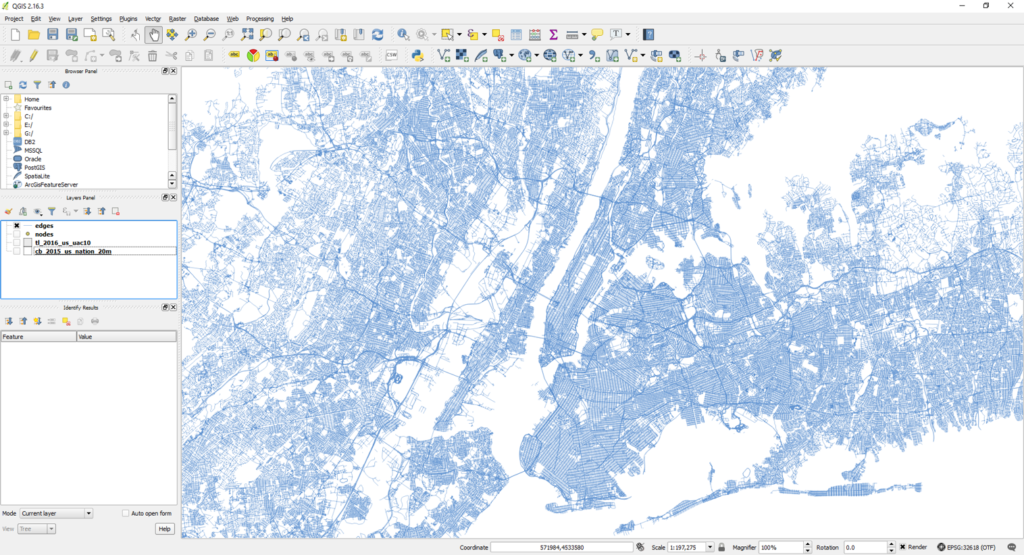 OSMnx can also save street networks as SVG files for design work in Adobe Illustrator:
OSMnx can also save street networks as SVG files for design work in Adobe Illustrator:
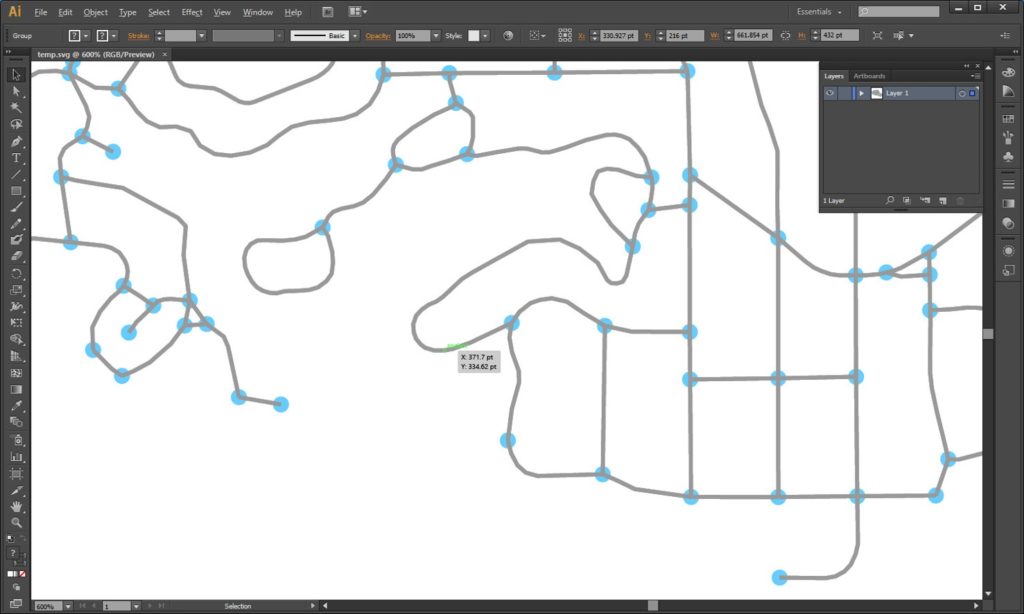 You can then load any network you saved as GraphML back into OSMnx to calculate network stats, solve routes, or visualize it.
You can then load any network you saved as GraphML back into OSMnx to calculate network stats, solve routes, or visualize it.
5. Analyze street networks
Since this is the whole purpose of working with street networks, I’ll break analysis out in depth in a future dedicated post. But I’ll summarize some basic capabilities briefly here. OSMnx is built on top of NetworkX, geopandas, and matplotlib, so you can easily analyze networks and calculate spatial network statistics:
G = ox.graph_from_place('Santa Monica, California', network_type='walk')
basic_stats = ox.basic_stats(G)
print(basic_stats['circuity_avg'])
extended_stats = ox.extended_stats(G, bc=True)
print(extended_stats['betweenness_centrality_avg'])
The stats are broken up into two primary functions: basic and extended. The extended stats function also has optional parameters to run additional advanced measures.
You can also calculate and plot shortest-path routes between points, taking one-way streets into account:
G = ox.graph_from_place('Piedmont, CA, USA', network_type='drive')
route = nx.shortest_path(G, orig, dest)
fig, ax = ox.plot_graph_route(G, route, route_linewidth=6, node_size=0, bgcolor='k')
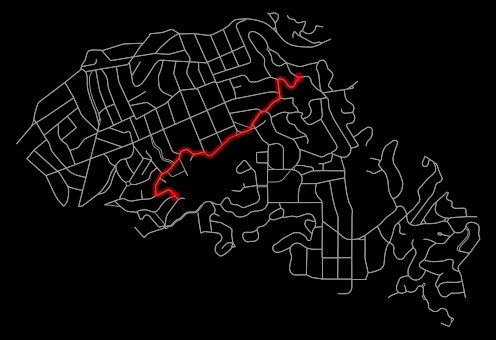 You can impute missing edge speeds and calculate edge travel times (see example) to contrast shortest paths by distance (red) vs by travel time (blue):
You can impute missing edge speeds and calculate edge travel times (see example) to contrast shortest paths by distance (red) vs by travel time (blue):
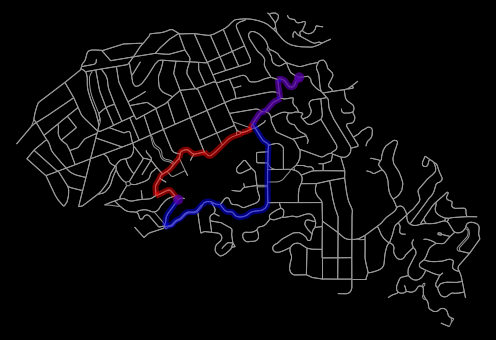 You can also visualize the compass orientation of street networks around the world:
You can also visualize the compass orientation of street networks around the world:
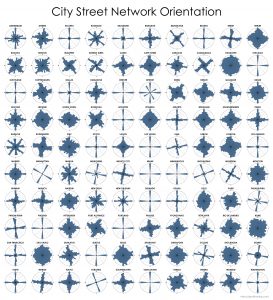 Allan Jacobs famously compared several cities’ urban forms through figure-ground diagrams of 1 square mile of each’s street network in his book Great Streets. We can re-create this automatically and computationally with OSMnx:
Allan Jacobs famously compared several cities’ urban forms through figure-ground diagrams of 1 square mile of each’s street network in his book Great Streets. We can re-create this automatically and computationally with OSMnx:
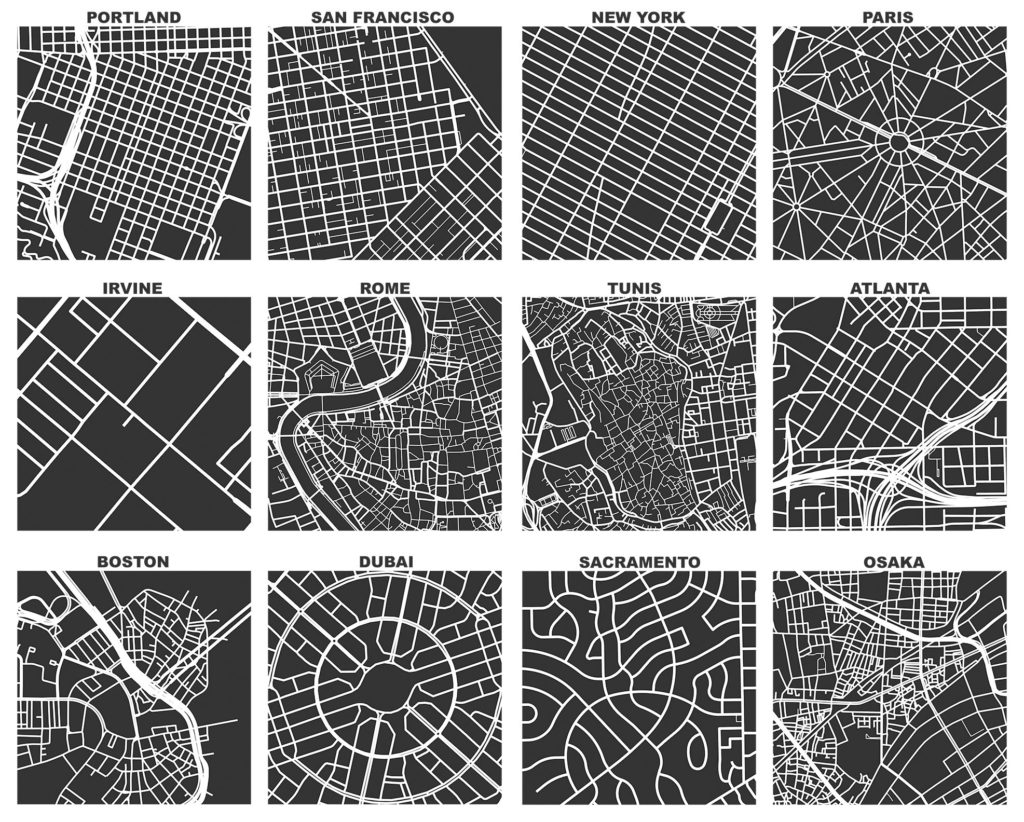 These figure-ground diagrams are created completely with OSMnx.
These figure-ground diagrams are created completely with OSMnx.
Conclusion
OSMnx lets you download spatial geometries and model, project, visualize, and analyze real-world street networks. It allows you to automate the data collection and computational analysis of street networks for powerful and consistent research, transportation planning, and urban design. OSMnx is built on top of NetworkX, matplotlib, and geopandas for rich network analytic capabilities, beautiful and simple visualizations, and fast spatial queries with r-tree, kd-tree, and ball-tree indexes.
OSMnx is open-source and on GitHub. You can download/cite the paper here.
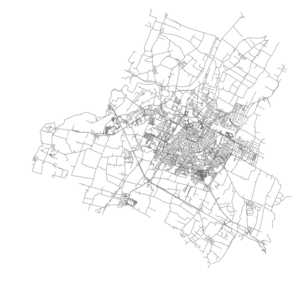
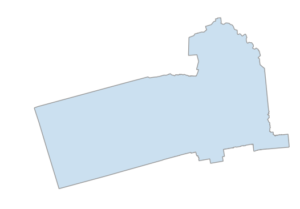


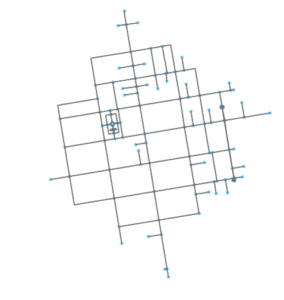
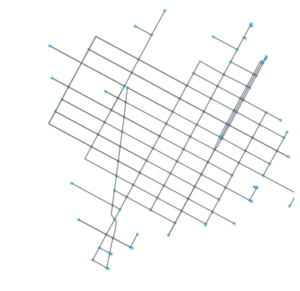
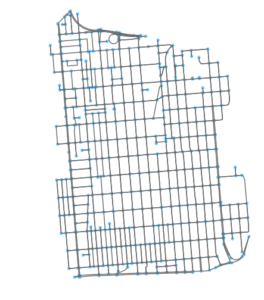

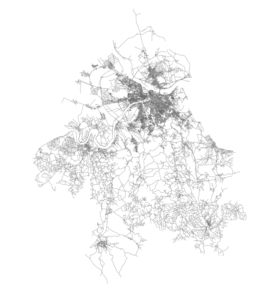
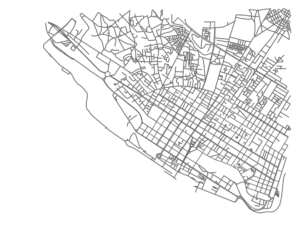
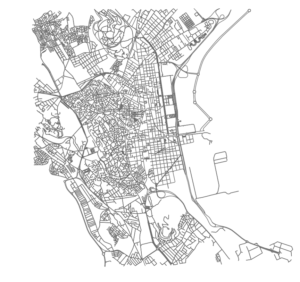
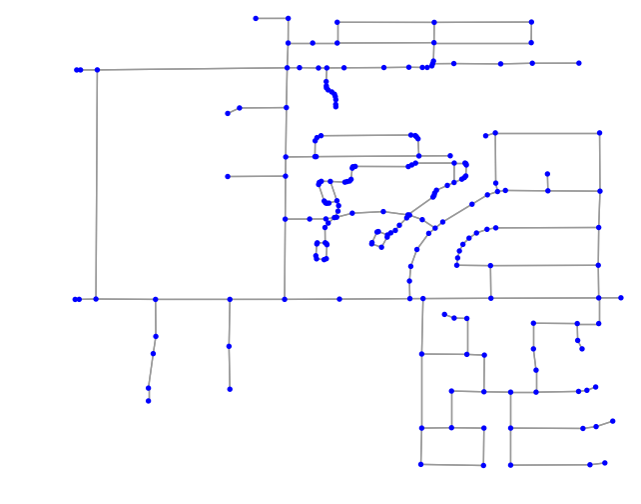
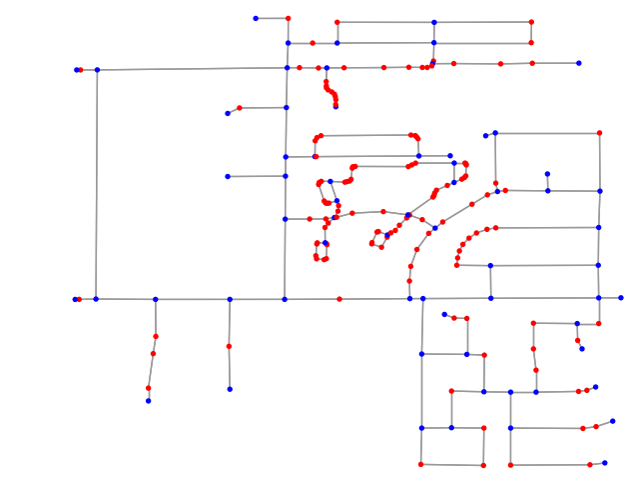

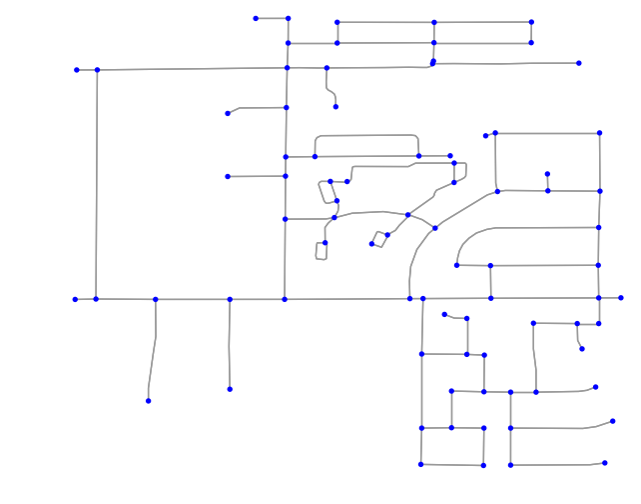
205 replies on “OSMnx: Python for Street Networks”
[…] my favorite comes from Geoff Boeing, who wrote OSMnx, a python module for extracting street networks from OpenStreetMap and then do all kinds of […]
Great article!
I have the following questions:
1- How can I convert the graph metrics (basic and extended) to a geopandas frame?
2- Can I get graph metrics for a specific MGRS grid, for example within a 100×100 meters grid?
Thank you in advance.
Thanks for this great article gboeing.
Suppose we run this command:
import osmnx as oxox.plot_graph(ox.graph_from_place('Modena, Italy'), network_type='drive'))
How could we fine out whether a GPS Coordinate lies on a specific road ?
e.g. if we assign an id to each road (in the network), then give a list of gps lat and long, could we determine which (lat, long) combination lies on which road id ?
Sounds like you’re looking for the get_nearest_edge function: https://osmnx.readthedocs.io/en/stable/osmnx.html#osmnx.distance.get_nearest_edge
Congratulations, will be following this to see where it goes.
Hi Geoff,
thank you for this great resource!
How can we export the data as a GeoJSON file? Is this possible?
Do you know how can we use this data to build the city blocks from the street network?
Thanks!
Thanks. I’ll be adding GeoJSON export in an upcoming version. It’ll be a simple feature to add. City blocks is a good question, and something I am currently researching. The ambiguity lies in the definition of a city block. One thing you can do is polygonize your set of edge lines and treat the polygons as blocks. There will be some strange artifacts there, but it’s a proxy. Looking forward to your suggestions as you delve into this.
Hey Geoff, amazing work! OSMnx is really easy to use and incredibly useful! I was wondering whether you already implemented the GeoJSON export. Thank you.
Best,
Chris
Hi Geoff,
First of all, great work! Congrats! Second, I’d like to ask you how the tool manages multiple parallel lines (e.g., big roads with multiple lanes, footpaths, cycle ways etc.) and roundabouts. Does it shrink everything in single neat lines and intersections?
Thanks in advance,
Alessandro
Thanks. OSMnx handles edges however OSM provides them. That said, roads with multiple lanes are represented as a single edge (and the edge has optional attributes of number of lines, width, road type, etc.). Divided roads are represented as directed edges going in reciprocal directions, but offset from each other such that they are (approximately) center-lines for each direction. Roundabouts are represented as roundabouts, as they are on OSM. Reducing parallel, nearby paths to single edges is a non-trivial computational task.
Hi Geoff,
I am working on a use case where in my GPS points are not 100% accurate hence in the above case of multiple lanes a given point might fall on the other lane due to GPS error. How do I reduce nearby paths to single edges to handle my GPS error?
Can i extract the road network for a city in China?
I try but it’s not working for some Asian cities. Any solution to that?
Hi Geoff,
this tool is amazing. You’ve done a really great job.
I’d like to ask you if there is any way to “disable” nodes, which are at the ends of roads in order to extract “true” intersections only?
Thanks a lot!
Yes you can easily identify which nodes are actual intersections, vs dead-ends. OSMnx creates a graph attribute that states how many physical streets are connected to each node. Any node with >1 is an intersection. For example:
G = ox.graph_from_place('Piedmont, California, USA', network_type='drive')streets_per_node = G.graph['streets_per_node']
node_ids = set(G.nodes())
intersections = [node for node, count in streets_per_node.items() if count>1]
dead_ends = [node for node, count in streets_per_node.items() if count==1]
this looks great Geoff, thanks for releasing this. Do the networks interface directly with pandana?
Not directly, but it would be possible to interface with a little bit of connector code to hook up to pandana’s loaders.
cool. This seems like a good solution to the large networks issue i raised (and i think you suggested the same once?)
[…] presenta la librería python OSMnx. Fue escrita durante su disertación, y permite la visualización y análisis de datos de […]
This looks awesome. I just started playing with it and noticed your example for `ox.graph_from_bbox()` you pass a list and a network_type, however when I try that it gives me a “need at least 4” parameters error. Seems to work fine if I pass each of the bbox coordinates separately, eg like so: `ox.graph_from_bbox(bbox[0], bbox[1], bbox[2], bbox[3], network_type=’drive_service’)`.
Cheers.
Ah yes, thanks for catching that. Old code. Just updated it.
Wow! Amazing work! For real… awesome!
Congrats on such a useful and simple-to-use library!
Rafael Pereira mentioned your work on a post of his blog… I will definitely be following you from now on!
#ThanksGeoff
Hi Geoff,
Congratulations for this neat piece of code. I’ll try to use it for my studies. I do exactly what this tool is meant for on a daily basis. Will hopefully come up with more to discuss.
Zia
PhD in Geomatics Engg.
This is amazing!
Hi Geoff,
Could you share the code you used to make the Jacobsesque figure-ground diagrams? Again, this is a fabulous tool for urban designers everywhere.
Best,
Yasir
Sure. I’m working on a blog post for it – will update soon.
Here’s a follow-up blog post about the Allan Jacobs style figure-ground diagrams, including the code to re-create them.
Hi Geoff,
your work is awesome!congrats!
Is this possible to load data as a big matrix into the memory?
thanks a lot.
Sure, you can easily convert networkx graphs to/from pandas or geopandas dataframes.
Hello
Nice work !
I found your article because I am looking for a way to extract contours from OSM and draw them on a tiles. For example, using folium, you can easily add markers or draw polygons on the map.
But it is sometimes not easy to find the coordinates of administrative regions (out of USA). With your module, with simple requests you can easily get it.
Is there a way to do plot on a tiles with OSMnx ? or Do you know another module which can be used to do this ?
Thanks
You might check out smopy. I’ll be integrating it into an upcoming OSMnx release. It lets you plot OSM tiles in Python and draw geometries on top of them.
Hey, I’d love to try this but I’m having trouble with an rtree libspatialindex_c dependency, I’ve installed via conda-forge to no avail, and after looking at the rtree library it looks like a pretty common thing.
Is it possible the rtree dependency could be removed? Have you dealt with rtree c lib dependencies before?
Also the project looks really cool!
Thanks in advance!
What platform are you on? If you’re on Linux, you can install libspatialindex with apt-get. If you’re on Windows, you can install rtree (and its C extensions) easily with Gohlke’s binaries. I don’t have a Mac, but my students who are Mac users got rtree installed and working using conda and either the conda-forge or the IOOS channel. Make sure you’re using the latest versions of rtree (0.8.3) and libspatialindex. If you have any other problems, you can open an issue in the GitHub repo (or the relevant repo if someone’s dependency is broken for your platform).
Hello,
Fantastic work, thank you for sharing!
I got experience in Python but I am pretty new to the whole geospatial world – so sorry for the newbie question.
I would like to ask you how could I use osmnx to load my locally saved (road)-network and parse it correctly into networkx in order to be able perform the operations that you show (plotting, routing, and computing network metrics).
The locally saved road network is optimally in shapefile or geojson format. But probably I could also convert it prior (with command line operation or QGIS) to OSM format or into Spatial Database.
Can this be implemented with little effort? Are you planning to make this type of operation part of the main package?
Thanks
Hi Geoff – this is pretty great! Any way to integrate transit networks into this – e.g. bus and subway routes?
Thanks!
Hello
Fantastic work !
I would like to ask you, how could I load back the saved shapefile into a networkx graph object. Is this operation feasible?
Alternatively could I load locally saved files in OSM or spatial database format as graph, and then perform routing, network simplification in osmnx ?
[…] book and put it on the internet. As part of his dissertation, Boeing has developed a coding tool that draws from OpenStreetMap and visualizes any city’s street network to scale as a […]
Hi,
Thanks so much for the information. Seems like this could be very helpful. Is it possible for you to do an follow up explanation for someone with GIS experience but no coding experience? This will help agencies who want to perform such analysis but currently do not have the coding experience.
Thank you
Great Job! Do you plan add support for public transport networks?
[…] has written up an excellent introduction to OSMnx is worth reading to get a quick insight into OSMnx’s […]
[…] book and put it on the internet. As part of his dissertation, Boeing has developed a coding tool that draws from OpenStreetMap and visualizes any city’s street network to scale as a […]
Great project!
A general question – What would be the most efficient way to load graph into osmnx? what format is optimal?
loading data for an entire country using graph_from_place() can be a bit time consuming.
if we have the ID_node, how to get the coordination of this node?
When I run:
ox.plot_graph(ox.graph_from_place(‘Modena, Italy’))
I get this error:
File “C:\Python27\lib\site-packages\rtree\core.py”, line 116, in
raise OSError(“could not find or load spatialindex_c.dll”)
OSError: could not find or load spatialindex_c.dll
OSMnx depends on the rtree package, which depends on libspatialindex, per its documentation. I suggest installing OSMnx with conda as it handles the dependencies gracefully for you. If you have trouble with OSMnx, please open an issue at its GitHub repo.
Thanks for sharing this great tool!
Have you ever considered implementing isolines computation on top of it? I’m thinking to adopt OSMnx to calculate all the routes starting from a list of locations (their projections on the network geometries) and going X meters far.
PS: in my case the routes have no one-way or turn restrictions being pedestrian routes.
Yes I actually wrote a little isolines function recently. I will try to add it to GitHub soon.
It sounds great! Today I’ve been working on it, trying various solutions based on OSMnx output (even one with the spatial output imported in a spatial DB).
Now I’m testing another path with GeoPandas and NetworkX.
Here’s an example of isochrones with OSMnx: https://github.com/gboeing/osmnx/blob/master/examples/13-isochrones.ipynb
Right, ego graph is the key method. Thanks for sharing this notebook.
Though I’m working on something a little bit different (I will complete it today hopefully): I need the exact (interpolated) point X distance far from the starting, projected, positions. At the end I will have the set of linestrings of the exact paths, not aproximated to the network nodes.
hi,gobeing,i am a chinese students, i have some mistakes in installing osmnx,can you help me, i am so upset.it always show me ” TypeError: not enough arguments for format string”
If you’re having trouble with OSMnx, you can open an issue at its GitHub repo: https://github.com/gboeing/osmnx/issues
[…] Boeing has created a cool Python package called OSMnx. It imports data from Open Street Map (OSM) and turns it into a network to calculate properties […]
Hi, gobeing, when I run the following setences:
G = ox.graph_from_place(‘Los Angeles, California’, network_type=’drive’)
ox.plot_graph(G)
it shows nothing, I am confused
I get it, I use graph_from_address instead, and it succeeds.
Hello I am from Wuhan, China students, my name is Wu Yong, I would like to ask the administrative boundaries in some areas of China can not? Osmnx is to call that geocoding service?
[…] network (with cycling network data obtained from OpenStreetMaps via Geoff Boeing’s awesome OSMnx tool). These maps show access to jobs within 1.5 miles from each intersection in the city; cycling […]
[…] OSMnx makes it easy to generate statistics on street networks by city extent, or by polygon shape. Here are the stats for the study cities, clipping the bike network (including bike paths, excluding freeways) to the 5-mile circle: […]
This is similar to the tool from “A protocol to convert spatial polyline data to network formats and applications to world urban road networks”
https://www.nature.com/articles/sdata201646
They’ve made an ArcGIS, QGIS, and Python version.
OSMnx, the tool that you cited, and others like Spatial Design Network Analysis from Cardiff University (QGIS) or the Urban Network Analysis Toolbox from MIT (ArcGIS) have quite similar methods, right?
Yes indeed. They differ in their underlying GIS architecture (e.g., ArcGIS, QGIS, geopandas) and their data sources (e.g., loading shapefiles, downloading from OSM). But each performs various network analyses.
What does the key attribute in the shapefile export reference. In most cases there are two overlapping line segments with Key 0 and Key 1. These segments usually have a reference each other’s end nodes. Key 0 may have a to:1 from 0 and Key 1 may have a to:0 from 1.
That would be the networkx edge key, as it is a multidigraph: https://networkx.readthedocs.io/en/stable/reference/classes.multigraph.html
This seems like a mechanism to identify different edges that have the same start and stop nodes. I am guessing the Key=0 and Key=1 are bi-directions ? The Key values 2 and greater are a little confusing.
Hi Geoff,
Indeed a very useful and well put together code. I wish I had similar skills! Congratulations!
I have noticed you hard coded the Overpass API URL and there is no helper function to set the target API to a different instance except the official one. I have hosted Overpass API and OSM database with full global network to avoid overloading the official service and allow for more demanding queries. So far we use it with much success on full-scale POI’s city analysis and multi-agent transport simulations.
I was wondering if you would consider enabling custom setup of Overpass API URL via some utility function or setting variable.
Greate work!
With respect,
Catalin
Thanks Catalin. Yes I think this could be a useful feature to add.
Great tool! The code for visualising cul-de-sacs is not 100% correct anymore, it seems, on the version I am using. Should be:
streets_per_node, not streets_per_intersection.
You’re right — that attribute changed in a recent release. Thanks. Just updated the post.
[…] I discovered Geoff Boeing’s amazing OSMnx Python package. It’s an extremely useful tool and very well documented. Geoff used originally […]
Hey, this tool is awesome. Thanks very much for sharing it with us.
I’m developing my final work at my university and I have to know the distance between the point from an gived area (north, south, east, west).
Can I get them with your tool? Is there some method that I can download the street distances from a gived north, south, east and west?
Thanks for your attention!
Are you saying you’d like to download a street network within some north, south, east, west bounding box? If so, OSMnx has a built-in function to do this. You can see it demonstrated in the example notebook: https://github.com/gboeing/osmnx-examples/blob/master/notebooks/01-overview-osmnx.ipynb. You can then easily calculate distances between points.
I was trying to say that I need to download de matrix distances from a gived area.
For example: I have an area with max(lat, lon) and min(lat, lon) and I need to download the matrix distance from each point of this area to the others points from this area. I need to use the Dikjstra’s method to calculate the minimum path.
Can I get the matrix distance with your tool?
Thanks for your attention!
Hi. I have a question regarding the intersection of the streets in a city, say Berlin.
how can I get a list of intersections as well as the link between two intersections and the length of it?
thank you very much in advanced!
I’d suggest working through the examples and demos at https://github.com/gboeing/osmnx-examples to learn how this functionality works.
Hello gboeing congrats
G = ox.graph_from_address(‘N. Sicily Pl., Chandler, Arizona’, distance=800, network_type=’drive’)
route = nx.shortest_path(G, origin, destination)
ox.plot_graph_route(G, route)
error: name ‘nx’ is not defined
how i define nx?
thanks your help.
Did you import networkx as nx, as shown in the examples? Otherwise this might be a question better suited for troubleshooting on StackOverflow: https://stackoverflow.com/search?q=osmnx
oh, very kind, thank you
*******************************
one last question please
What does these values mean when you run a code?
(
)
thanks again
import networkx as nx
origin and destination are also not defined in the code
matplotlib.figure.Figure at 0x4223bfadd8
Hi Geoff,
I was fascinated to discover such a useful tool as OSMnx. Keep up the good work!
Started playing around with the examples from the docs. Plotting shape worked just fine. But running:
G = ox.graph_from_place(‘Iowa City, IA, USA’, network_type=’drive’)
ox.plot_graph(ox.project_graph(G))
returns: ‘TypeError: ‘method’ object is not subscriptable’
Any ideas on what caused the error or how it could be remedied?
Make sure your packages are up to date… solution here: https://github.com/gboeing/osmnx/issues/91
That fixed it! Thank you!
Hello,is here any way to only abstract highway in a large area?
Sure, just loop through the edges’ data dictionaries, and remove any edges from the graph if the “highway” value is not a category you want to retain.
Dear Geoff,
I am just a novice when it comes to programmatic data-visualization in Python, but I was wondering if there is a way to plot both the osmnx objects and scatterplot via standard matplotlib plt.scatter function?
Suppose I wanted to plot a road network constructed in osmnx together with the school size (scatter, with different sizes / colors). Is there a way to do it without exporting graph to *shp and then plotting it all together in another library like cartopy / basemap?
Here’s a simple example of plotting “other stuff” along with a street network: https://github.com/gboeing/osmnx-examples/blob/master/notebooks/07-example-plot-network-over-shape.ipynb
[…] blog post, github, abstract, paper, data […]
[…] OSMnx: Python for Street Networks […]
Hi Geoff,
Excellent tool and it is working smooth. Would it be possible to load an osm file which is already downloaded? I would like to play around with higher tier road networks on larger geographical areas (motorways, primary roads etc).
Thanks! Elco
Yes indeed — loading OSM files is a new feature now available in the master branch on GitHub, but not yet formally released.
Hello gboeing!
This is my first time here, and I’m not sure if it’s the proper place to ask.
However, as @ElcoK asked, I have been looking in the documentation of OSMnx for a way to load an OSM file that was saved on local disk.
Is it possible now? if so, are there any examples about that?
Thank you!
Yes, see the documentation: https://osmnx.readthedocs.io/en/latest/osmnx.html#osmnx.core.graph_from_file
Hello, dear Geoff.
Thank you for your contribution.
I have a question, can you convert or read a graphml file to graphX and work with mapreduce in Spark?
I’m doing a doctorate in Ecuador and I’m reviewing your tool and hadoop to see if I can do anything else.
thanks, see you
Sure, you can use OSMnx’s save_graphml file, then open the graphml in any other software: https://osmnx.readthedocs.io/en/stable/osmnx.html#osmnx.save_load.save_graphml
thanks Geoff , I will do the test
Dear Geoff,
Thank you for your contribution.
I have a question that how should I get the nodes and the distance between each node or connectivity of the nodes out of those of file and save to maybe txt file. I am doing the simple roadmap extraction and I just want to get the coordinates of nodes and connectivity. How should I do?
By connectivity do you mean adjacency? If so, networkx can just spit out an adjacency matrix for you. All the nodes’ coordinates are stored in the nodes’ data dictionaries as “x” and “y”.
Thank you very much! I will look into networkx for the adjacency matrix. However, do you mind to explain a little more for outputting node’ data dictionaries as a txt file?
Sincerely,
Fang
I’d suggest exploring the NetworkX documentation if you need more info about working with the data structures. Beyond that, you can just write data to disk the normal ways you would in Python.
@gboeing,
add_edge_lengths calculates great circle distance. How we can have actuall distance between of a edge? I was comparing distance and it was different on google maps bewteen 2 points
the add_edge_lengths function adds edge lengths to the unsimplified graph, so it’s not great-circle distance between the eventual endpoints. It’s the length to travel along the curvature (if present) of the edge. If you have a specific bug report, best to open on GitHub.
Dear Geoff,
In what part of my system are the shp. files I got in osmnx stored? Is there a default route?
The default is the “data” folder in the local working directory, but you can save shapefiles to any other path by passing in the “folder” argument.
Dear Geoff,
Thank you for your contribution.
I only want to get the node position(N nodes x(1:N) y(1:N) and connectivity matrix C(N,N), which C(i,j) is equal to 1 if node i and j connected, otherwise C=0. What should I do?
OSMnx produces NetworkX graphs, so your best bet would be to familiarize yourself with the NetworkX functionality and documentation: https://networkx.github.io/documentation/stable/
Hello, dear Geoff.
Thank you for your contribution.
I have a question, can you convert or read a graphml file to graphX and work with mapreduce in Spark?
I’m doing a doctorate in Ecuador and I’m reviewing your tool and hadoop to see if I can do anything else.
thanks, see you
Dear Geoff,
Thank you very much for this article.
It’s really useful !
This tool is amazing.
Thanks again,
Dear Geoff,
i just installed the Miniconda and run the conda install -c conda-forge osmx in the conda.exe. Then everything seemed to be installed but then at the end i got the following error: ERROR conda.core.link:_execute_actions: An error occurred while installing package ‘conda-forge: jupyter_core-4.4.0-py_0. Do you know exactly what it is?
This is a conda issue. If you’re on windows, run the command prompt as administrator. See also: https://github.com/conda/conda/issues/6078#issuecomment-335343644
Dear Geoff,
Thank you for your contribution.
Is there some way to get the major road of USA or Europe?
Hi Geoff,
I just installed osmnx (using conda), and tried to import it, but got the following error —
ImportError: dlopen(/Users/apal/anaconda2/lib/python2.7/site-packages/fiona/ogrext.so, 2): Library not loaded: @rpath/libuuid.1.dylib
Referenced from: /Users/apal/anaconda2/lib/libgdal.20.dylib
Reason: image not found
Do you know any fixes?
Thanks for using OSMnx. If you’re having any trouble with it, feel free to peruse its closed issues on GitHub, or open a new one if there’s a bug. It looks like you used conda to install it, so check out the conda-forge issue and answer here: https://github.com/conda-forge/osmnx-feedstock/issues/14#issuecomment-351447160
Hi Geoff,
Thank you very much for this nice work!
I was wondering if it is possible to obtain, in addition to the map, data about the plotted graph (e.g. links, nodes, connectivity, lengths).
Best,
Michele
Hi Michele. Yes it is. Your best place to start would be with the OSMnx documentation and the examples of this on GitHub.
Hi Geoff,
The tool is amazing, I have a question though
How does the OSMnx recognize in which direction traffic is allowed for oneway roads?? In the direction of OSM digitalization? Coz when I save a network (OSMnx) as shapefile and open it in Qgis, the direction of lines (oneways) does not correspond with the original data downloaded from overpass.
Thanks for reply
Andre
In the shapefile, the edges have attributes for “oneway” (True/False), “u”, and “v”. If it is one way, the edge is directed from node with ID u to node with ID v.
Hi Dear Geoff,
Can you help me locate the hospitals nodes on a map,
I want to see the Betweeneess centrality of hospitals
thanks for your great help and contribution
Dear Geoff,
Could you please tell me if it is possible to extract the faces of street network graph (blocks surrounded by streets)?
Thanks
Sure. Extract the edge geometry as linestrings, then polygonize them with a geometry package like shapely.
Hi there!
Great work and I’m looking forward very much to progressing further through the tutorials and papers.
I’ve been trying to get Edinburgh in Scotland to show up but for some reason the name taken from OSM doesnt work. Would you be able to give me any pointers as to why this may be?
As a side note this is how I’ve been getting other areas such as Melbourne to produce graphs. Hope this info helps in the query!
Dan
Hi Geoff,
Thanks a lot for your work on OSMnx. It is really cool tool and I have been enjoying using it for my research. Could you please provide (or forward to) a more detailed steps for obtaining graph from a shaplefile polygon?
I have a question regarding to obtaining a street network from polygons. I have opened a GDB file in ArcMap and saved it in shapefile format, which has been used as input for the ox.graph_from_polygon command. However, I have been seeing this error and haven’t been able to figure out why.
%%%%Code Begins%%%%%%
import osmnx as ox
import networkx as nx
import geopandas as gpd
SN_16=gpd.read_file(r’C:\Users\*******\SN_16.shp’)
G_16 = ox.graph_from_polygon(SN_16, network_type=’drive’)
ox.plot_graph(G_16)
—————————————————————————
ValueError Traceback (most recent call last)
in ()
—-> 1 G_16 = ox.graph_from_polygon(SN_16, network_type=’drive’)
2 ox.plot_graph(G_16)
~\AppData\Local\Continuum\anaconda3\lib\site-packages\osmnx\core.py in graph_from_polygon(polygon, network_type, simplify, retain_all, truncate_by_edge, name, timeout, memory, max_query_area_size, clean_periphery, infrastructure)
1665 # verify that the geometry is valid and is a shapely Polygon/MultiPolygon
1666 # before proceeding
-> 1667 if not polygon.is_valid:
1668 raise ValueError(‘Shape does not have a valid geometry’)
1669 if not isinstance(polygon, (Polygon, MultiPolygon)):
~\AppData\Local\Continuum\anaconda3\lib\site-packages\pandas\core\generic.py in __nonzero__(self)
1119 raise ValueError(“The truth value of a {0} is ambiguous. ”
1120 “Use a.empty, a.bool(), a.item(), a.any() or a.all().”
-> 1121 .format(self.__class__.__name__))
1122
1123 __bool__ = __nonzero__
ValueError: The truth value of a Series is ambiguous. Use a.empty, a.bool(), a.item(), a.any() or a.all().
I have been using Jupyter in Anaconda. I would greatly appreciate if anyone could comment on this.
You are passing a GeoDataFrame rather than a polygon. See the documentation and examples.
Hey Geoff,
I am having a similar problem. The docs and examples don’t detail very well how to do this. In the examples, all I can find is:
calif = gpd.read_file(‘input_data/ZillowNeighborhoods-CA’)
mission_district = calif[(calif[‘CITY’]==’San Francisco’) & (calif[‘NAME’]==’Mission’)]
polygon = mission_district[‘geometry’].iloc[0]
G6 = ox.graph_from_polygon(polygon, network_type=’drive_service’)
I used this to open a geojson, then used iloc as well, and I am still getting no luck, on multiple files, with the message that it is not a valid polygon.
The documentation otherwise excludes the instructions regarding geopandas, and simply asks for a polygon. Maybe geojson is simply not supported, even if opened with geopandas and if geopandas can be used to show the geometry?
You can use geopandas, geojson, whatever you want to load the data as long as you provide OSMnx a valid polygon from that data. Best to ask a usage question at https://stackoverflow.com/search?q=osmnx as it’s hard to respond with troubleshooting in blog comments.
Hi Geoff:
Thank you for your great contribution!
When I am using the function ox.graph_to_gdfs and get the database, what are those features of a road, some of them (maxspeed, oneway…) are easy to understand but some (access, key, ref, service…) are confusing me. Where can I find document for them?
All of these features are explained in OpenStreetMap’s documentation, e.g.: https://wiki.openstreetmap.org/wiki/Key:service
Hi Geoff
Thanks for this amazing and quite helpful resource.
One question: I am creating a graph from an osm file and then plotting it. While doing this, it is also plotting building along with the roads. Is there a way to remove buildings from this graph/just ignore buildings while creating a graph from that osm file?
Thanks
Might be a better question for https://stackoverflow.com/search?q=osmnx
Hi Geoff,
Thank you for this easy-to-use tool.
I am wondering if there is a way to use shortest_path on multiple points to create a shortest route planner. (Travelling salesman problem)
Thank you
Hi Geoff,
I have been unable to work with any cities in Virginia. Using the examples provided, I am able to export city boundaries in various other states but when I try Virginia Beach (or any other city in Virginia) it prompts an error. Any clue as to what the issue may be?
import osmnx as ox
place = ox.gdf_from_place(‘Virginia Beach, Virginia’)
ox.plot_shape(ox.project_gdf(place))
You might want to check this out for some suggestions: https://github.com/gboeing/osmnx/issues/16
[…] 完全な概要 […]
Geoff,
Thank you very much. This worked perfectly and rectified the problem.
What a fantastic package you’ve provided. Thank you!
Kind Regards,
Nick
This is fascinating!
I’d be interested in using it to find all streets, roads, avenues, etc with a particular name (in my case, “Henry Dunant”). Is there a way to query this quickly, or should I download each and every city and then filter?
OMG, such a great idea! Found it there https://meduza.io/shapito/2018/07/14/issledovatel-iz-ssha-pridumal-udivitelnuyu-vizualizatsiyu-ob-yasnyayuschuyu-ustroystvo-gorodov-a-my-s-ee-pomoschyu-posmotreli-na-rossiyskie
and was amazed. But sad that there is no web page for the application, I mean, if someone who is not familiar with Python wants to get the scheme for his city, it seems not so easy:(
So the question, can anyone help me to get the pic for one small town in Siberia called ‘Abakan’, pls, send to woft02@gmail.com .
I and all the Siberian bears will be very thankful!:)
[…] library: osmnx, which uses OSM API, geopandas and networkx. Those are all I frequently used tools. OSMnx: Python for Street Networks is developed by Geoff Boeing, one Urban planning postdoc at UC Berkeley. It can help you to […]
[…] work of Geoff Boeing who wrote a blog post "Comparing City Street Orientations" using his OSMnx Python library. In a description of OSMnx Christoph linked to a number of blog posts about OSMnx […]
Hi Geoff.
This is just a great tool and it is being super useful for urban morphology.
Quick question: Is it possible to extract parts of a loaded graph G?
What I’m trying to do is to divide the city according a regular grid and then compare the network statistics for each cell on the grid. I want to avoid a separate call to OSM server for each cell, and instead to use a previously saved .osm file for the whole area. So my approach would be:
1. Load the .osm file
2. Recursively get either the boundaries or the polygon for each cell and extract a sub-graph for the given cell.
3. Compute nx statistics for each subgraph.
4. Use a clustering algorithm to classify the cells into similar groups according their network characteristics.
I’m stuck on step 2. Any advice will be extremely helpful.
Best,
Daniel
In short: convert the graph nodes to a geopandas GeoDataFrame using OSMnx, then for each cell polygon: intersect those nodes with your polygon and induce a subgraph on those intersecting nodes.
Hi Geoff! First of all, it might be one of the best python package I’ve ever used. Congrats!!! Second, I would like to extract a road network of a whole country. For sure, I do not need a high level of of details. Ideally I want to retrieve only the biggest freeways of a territory. I think it might be possible by playing the infrastructure or the filter argument but I failed. Can you help me?
Hi Geoff,
Is there a way to draw a line across multiple points instead of just 2. Kind of like the Google maps multiple destinations. I thought of using nodes and edges information but I see that the graph just takes in the orig_node and dest_node and not a collection of nodes.
Thanks
Yes, see https://osmnx.readthedocs.io/en/latest/osmnx.html#osmnx.plot.plot_graph_routes
Thanks. I got the plot_graph_routes working. So it stores the bunch of edges in an array for multiple destination. However it seems that destinations might have paths overlapping each other as each point-point distance is calculated individually. Is there a way to simplify and remove the redundant links between these points ?
Kind of like a minimum spanning tree ?
Thanks.
Hi Geoff,
I was wondering whether there is a way to map a given GPS point to its nearest edge, using your library?
Thank you!
Yes. For instance you can find the nearest node to the GPS point, then look up its incident edges: https://osmnx.readthedocs.io/en/stable/osmnx.html#osmnx.utils.get_nearest_node
Hi Geoff,
When I was running:
city = ox.gdf_from_place(‘Berkeley, California’)
ox.plot_shape(ox.project_gdf(city))
I got the following errors
—————————————————————————
RuntimeError Traceback (most recent call last)
in ()
1 import osmnx as ox
2 city = ox.gdf_from_place(‘Berkeley, California’)
—-> 3 ox.plot_shape(ox.project_gdf(city))
~\Anaconda3\lib\site-packages\osmnx\projection.py in project_gdf(gdf, to_crs, to_latlong)
117
118 # project the GeoDataFrame to the UTM CRS
–> 119 projected_gdf = gdf.to_crs(utm_crs)
120 log(‘Projected the GeoDataFrame “{}” to UTM-{} in {:,.2f} seconds’.format(gdf.gdf_name, utm_zone, time.time()-start_time))
121
~\Anaconda3\lib\site-packages\geopandas\geodataframe.py in to_crs(self, crs, epsg, inplace)
441 else:
442 df = self.copy()
–> 443 geom = df.geometry.to_crs(crs=crs, epsg=epsg)
444 df.geometry = geom
445 df.crs = geom.crs
~\Anaconda3\lib\site-packages\geopandas\geoseries.py in to_crs(self, crs, epsg)
302 except TypeError:
303 raise TypeError(‘Must set either crs or epsg for output.’)
–> 304 proj_in = pyproj.Proj(self.crs, preserve_units=True)
305 proj_out = pyproj.Proj(crs, preserve_units=True)
306 project = partial(pyproj.transform, proj_in, proj_out)
~\Anaconda3\lib\site-packages\pyproj\__init__.py in __new__(self, projparams, preserve_units, **kwargs)
356 # on case-insensitive filesystems).
357 projstring = projstring.replace(‘EPSG’,’epsg’)
–> 358 return _proj.Proj.__new__(self, projstring)
359
360 def __call__(self, *args, **kw):
_proj.pyx in _proj.Proj.__cinit__()
RuntimeError: b’No such file or directory’
Any ideas on what caused the error?
Thanks
This is a pyproj issue and has been documented and solved on GitHub: https://github.com/gboeing/osmnx/issues/205
Hi man !
I can’t connect to overpass
simply :
import osmnx as ox
ox.plot_graph(ox.graph_from_place(‘Modena, Italy’))
doesn’t work for me !!!
What can i do to fix this problem ?! I know the server was down – but requests dont work still :(((
I also noticed that yr app gets more nodes that openstreetmap per box – how can this happen ?
thnk you in advance!!!
Please ask general usage questions on StackOverflow at https://stackoverflow.com/?q=osmnx
Hello !
os.graph_from_place not working !!!!
Please ask general usage questions on StackOverflow at https://stackoverflow.com/?q=osmnx
Hello!
Here’s a problem. When I use ox.get_nearest_nodes(G2, X=[116.394918,116.394645885],Y=[39.921473,39.8441762844],method=’kdtree’), the return value is the same as array([3247592810,3247592810])
If you’ve run into a bug, please open an issue on GitHub.
[…] methods to transform OpenStreetMap (OSM) roads into valid graph objects. Their tools Pandana and OSMNx both download and clean up OSM road data through steps like removing points that don’t represent […]
[…] started with a list of the top 100 U.S. cities by population, and used Geoff Boeing’s OSMNX package to search OpenStreetMap for streets named “Martin Luther King”. (52 of those […]
Hi, Geoff! Your packages is awesome and very clean. Really a nice and useful work.
I have a short question and i didn’t find any related in StackOverflow, issues’ github, etc.
Me and my team working calculate some distances using NetworkX, downloading the OSM network directly from Geofabrik, but for a specific date. So, we do not know if your methods to get network from polygons (will) have a method to specific the OSM network date to be download. ¿Is there a way/a parameter to do that with your methods? It’s necessary compare data from 2016 with the OSM network from same year (month, etc) to get an coherent analysis instead of use the latest downloaded network.
Finally, ¿What datetime has download network when i use the method ‘get_from_point/polygon’?
Sorry for my bad english :D.
Thanks!
The datetime of the data downloaded with OSMnx is whatever was available via the Overpass API at the time of the download. It doesn’t filter by elements’ dates.
[…] noted that the osmnx package has trimmed redundant nodes (see section 3 on this page) in the network retrieved from OpenStreetMap, meaning nodes that are just a bend in the road […]
Hi, Geoff
thanks for your contributions
A question if you can help me please
how to convert a node 5489469349 to a coordinate lat, lon?
Best regards
[…] OSMnx ที่พัฒนาโดย Geoff Boeing […]
Amazing job!
[…] connectivity, granularity, and entropy in 100 cities around the world using OpenStreetMap data and OSMnx for modeling and […]
Hi Geoff,
Since Several days I a trying finding the number of points (coordinates of data with lat and lon) that are within two nodes of a multi-graph I have obtained with the osmnx library. Basically, I want to count the number of car (equipped with GPS) that crossed an edge between two nodes.
Thanks so much for your help!
Best
Federico
Hi Geoff,
Is there any way to annotate on map .
Thanks
Hello!
I just downloaded the OSMNX data for a city of interest. I do not understand what the est_width variable mean. I would like to use this information. Thank you
https://wiki.openstreetmap.org/wiki/Key:width#Estimated_values
HI Thanks for the library, it is of great help.I do have a doubt though. When I use nx.shortest_path_length . i get a length measure. I am not sure if it is in km or miles or someother unit of measure. Kindly clarify.
If you are using weight=”length” to weight the shortest path by distance traveled, then it is in whatever units your graph distances are in (meters by default). Consult the documentation: https://osmnx.readthedocs.io/en/stable/
Can I extract the road network for a city like Addis Ababa, ETHIOPIA?
and can I use OSMnx for my masters research title in urban network analysis and spatial configuration .
is that possible for country like ETHIOPIA. TO extract all road features
hello, proffessor I am very happy to meet with you.on your site. my name is Abdisa Bafikadu from Addis Ababa, Ethiopia I am road transport masters student from Addis Ababa Science and technology how I can use Osmnx for my research? my research is urban network analysis is that possible to use for developing country like our country Ethiopia?
Hi, I have a problem with my OSM project, I am trying to extract city blocks as polygons, I was able to get extract it for some points but it does not work universally, can anyone please help me? Link to my problem with code is here: https://stackoverflow.com/questions/60147207/single-positional-indexer-is-out-of-bounds
[…] OSMnx: Python for Street Networks […]
Hi Geoff,
My environment is python 3.7 and after installing OSMnx.
I try to run the demo as below.
import osmnx as ox
city = ox.gdf_from_place(‘Berkeley, California’)
ox.plot_shape(ox.project_gdf(city))
Then errors occur as:
D:\Anaconda\envs\osmnx_env37\python.exe G:/街景/hsv0212/OSM1.py
Traceback (most recent call last):
File “D:\Anaconda\envs\osmnx_env37\lib\site-packages\urllib3\connectionpool.py”, line 654, in urlopen
conn = self._get_conn(timeout=pool_timeout)
File “D:\Anaconda\envs\osmnx_env37\lib\site-packages\urllib3\connectionpool.py”, line 274, in _get_conn
return conn or self._new_conn()
File “D:\Anaconda\envs\osmnx_env37\lib\site-packages\urllib3\connectionpool.py”, line 964, in _new_conn
“Can’t connect to HTTPS URL because the SSL module is not available.”
urllib3.exceptions.SSLError: Can’t connect to HTTPS URL because the SSL module is not available.
During handling of the above exception, another exception occurred:
Traceback (most recent call last):
File “D:\Anaconda\envs\osmnx_env37\lib\site-packages\requests\adapters.py”, line 449, in send
timeout=timeout
File “D:\Anaconda\envs\osmnx_env37\lib\site-packages\urllib3\connectionpool.py”, line 720, in urlopen
method, url, error=e, _pool=self, _stacktrace=sys.exc_info()[2]
File “D:\Anaconda\envs\osmnx_env37\lib\site-packages\urllib3\util\retry.py”, line 436, in increment
raise MaxRetryError(_pool, url, error or ResponseError(cause))
urllib3.exceptions.MaxRetryError: HTTPSConnectionPool(host=’nominatim.openstreetmap.org’, port=443): Max retries exceeded with url: /search?format=json&limit=1&dedupe=0&polygon_geojson=1&q=Berkeley%2C+California (Caused by SSLError(“Can’t connect to HTTPS URL because the SSL module is not available.”))
During handling of the above exception, another exception occurred:
Traceback (most recent call last):
File “G:/街景/hsv0212/OSM1.py”, line 2, in
city = ox.gdf_from_place(‘Berkeley, California’)
File “D:\Anaconda\envs\osmnx_env37\lib\site-packages\osmnx\core.py”, line 68, in gdf_from_place
data = osm_polygon_download(query, limit=which_result)
File “D:\Anaconda\envs\osmnx_env37\lib\site-packages\osmnx\downloader.py”, line 282, in osm_polygon_download
response_json = nominatim_request(params=params, timeout=30)
File “D:\Anaconda\envs\osmnx_env37\lib\site-packages\osmnx\downloader.py”, line 334, in nominatim_request
response = requests.get(url, params=params, timeout=timeout, headers=get_http_headers())
File “D:\Anaconda\envs\osmnx_env37\lib\site-packages\requests\api.py”, line 76, in get
return request(‘get’, url, params=params, **kwargs)
File “D:\Anaconda\envs\osmnx_env37\lib\site-packages\requests\api.py”, line 61, in request
return session.request(method=method, url=url, **kwargs)
File “D:\Anaconda\envs\osmnx_env37\lib\site-packages\requests\sessions.py”, line 530, in request
resp = self.send(prep, **send_kwargs)
File “D:\Anaconda\envs\osmnx_env37\lib\site-packages\requests\sessions.py”, line 643, in send
r = adapter.send(request, **kwargs)
File “D:\Anaconda\envs\osmnx_env37\lib\site-packages\requests\adapters.py”, line 514, in send
raise SSLError(e, request=request)
requests.exceptions.SSLError: HTTPSConnectionPool(host=’nominatim.openstreetmap.org’, port=443): Max retries exceeded with url: /search?format=json&limit=1&dedupe=0&polygon_geojson=1&q=Berkeley%2C+California (Caused by SSLError(“Can’t connect to HTTPS URL because the SSL module is not available.”))
Process finished with exit code 1
Do you hava any idea abt that error? I have been looking at ways to figure it out but it still remains unsolved.
Thanks
Best
Vincent
Hi Vincent, Geoff,
Did you have any idea about this error ? I got the same one this afternoon and didn’t manage to figure it out.
Thanks,
Kind Regards,
Rémy
If you’re having trouble, can you ask the question on StackOverflow? Tough to troubleshoot code in the blog comments.
HI Thanks for the library, it is of great help.
I wonder how can we save the shortest route into disk as shpfile format data?
Thanks a lot.
Hello Mr. Geoff,
I am a Phd student in computer science, and i am working on finding the optimal path in a smart city, so i found your project OSMnx, and i think that it is an interesting tool to analyse street networks.
So, i would like to ask you please, if i can implement and test my proposal algorithm to find the shortest path in OSMnx, and get results ? if yes, what are the modules that i should modify, and where can i add my contribution in OSMnx?
Thank you very much for your help
Regards
[…] OSMnx underwent a major overhaul this summer, with the development of several new features, improvements, and optimizations. This project concluded yesterday with the release of v0.16.0. […]
Great article Geoff!
I have some questions:
1- How can I convert the graph metrics and stats to a geopandas frame? Basic and extended stats?
2- How can I get the graph metrics within a specific MGRS grid? It’s possible to get the general metrics from a bbox, but what about a specific MGRS grid, 100×100 meters grid? Can I retrieve this information from an MGRS grid id?
Thank you in advance.
Regards.
[…] the US census bureau, then modeled and analyzed all the tracts’ street networks using Python, OSMnx, and OpenStreetMap […]
[…] https://geoffboeing.com/2016/11/osmnx-python-street-networks/ […]
[…] new year! After five years of development and over 2,000 code commits from dozens of contributors, OSMnx v1.0 has officially been released. This has been a long labor of love and I’m thrilled to see […]
[…] Das Bild mit den Strassen von Bern im Header habe ich schnell mit der Hilfe von osmnx und dessen Beispiel-Notebook 7 […]
Hello Mr. Geoff,
I am a urban designer in shenzhen, and I am interesting in your OSMnx tools to analyse street networks.
When I use two differcnt method to calculate a same place area, and got two results. These two results not in inconformity with area I download from administrative boundary jison(correct and reshape).
method 1
place = “黄埔区”
gdf = ox.geocode_to_gdf(place)
area = ox.project_gdf(gdf).unary_union.area
G = ox.graph_from_place(place, network_type=”drive”)
area
result:482347181.26265496
method 2
G = ox.graph_from_place(‘黄埔区’, network_type=’drive’)
G_proj = ox.project_graph(G)
nodes_proj = ox.graph_to_gdfs(G_proj, edges=False)
graph_area_m = nodes_proj.unary_union.convex_hull.area
graph_area_m
result:565770922.8681948
When I use qgis import this area from administrative boundary, its 484042855 m2.
In general, for this area comes from ‘drive’, so area is smaller than the area from administrative boundary.
So ,I want to know if these two methods use different area, and I found method 1 area result suit for old city such as guangzhou ,and has large deviation in shenzhen. Method 2 is suit for shenzhen , smaller than administrative boundary(I think it reasonable), but has great difference with old city as guangzhou.
Thank you very much for your help
Regards
Hello Geoff,
Thanks for this article. It is very interesting. I would like to generate and analyse the network traffic of a city in SUMO. Please how can I save the map that I have retrieved using osmnx to use it in SUMO.
Thank you very much for your help.
Regards.
[…] I needed to install OSMnx. OSMnx is a great Python module for working with street networks and Open Street Map. Instead of installing with Conda, we will use it’s smaller and faster cousin, Micromamba to […]
Hi Geoff !
Is there way to find several shortest distances – routes ?
For instance, if the route contains too many turns, then other route may be better than it ?!
Great article. I just want to ask: can you advise me how to get all the coordinates of all the streets in one US City one time by using python osmnx ?
Hello Geoff,
I am always getting this issue with the most recent version of all the Python packages:
SSLCertVerificationError: [SSL: CERTIFICATE_VERIFY_FAILED] certificate verify failed: unable to get local issuer certificate (_ssl.c:997)
MaxRetryError: HTTPSConnectionPool(host=’nominatim.openstreetmap.org’, port=443): Max retries exceeded with url: /search?format=json&polygon_geojson=1&dedupe=0&limit=50&q=Berkeley%2C+California (Caused by SSLError(SSLCertVerificationError(1, ‘[SSL: CERTIFICATE_VERIFY_FAILED] certificate verify failed: unable to get local issuer certificate (_ssl.c:997)’)))
Thank you!
Francois
[…] 官方文档地址官方文档的大致介绍 […]
[…] https://geoffboeing.com/2016/11/osmnx-python-street-networks/ […]
[…] https://geoffboeing.com/2016/11/osmnx-python-street-networks/ […]
[…] 官方文档地址 官方文档的大致介绍 […]
This is one of my favourite libraries – really good work. I especially love the auto simplification and removal of excess nodes when using ‘graph_from’. If you are still making improvements it would be useful if this same simplification can be applied when using features_from or if alternatively if non-paths can be collected from the API as graphs. Ran into a little problem with ski trails :)
[…] We mentioned that spatial data of any nature can be analyzed: social data, natural objects or artificial constructions. Let’s look even deeper into the source code. From the figures we can see that distance calculation is performed on routes built with regard to roads, which is reasonable, because usually we don’t fly to bars by helicopters, but walk. Therefore, the ‘distance’ analysis includes the search for routes on the road graph, using the one from OSM. That is, the algorithm searches for a route on the following abstractions (we relied on the following article, highly recommended — OSMnx: Python for Street Networks): […]
[…] We mentioned that spatial data of any nature can be analyzed: social data, natural objects or artificial constructions. Let’s look even deeper into the source code. From the figures we can see that distance calculation is performed on routes built with regard to roads, which is reasonable, because usually we don’t fly to bars by helicopters, but walk. Therefore, the ‘distance’ analysis includes the search for routes on the road graph, using the one from OSM. That is, the algorithm searches for a route on the following abstractions (we relied on the following article, highly recommended — OSMnx: Python for Street Networks): […]
[…] We mentioned that spatial data of any nature can be analyzed: social data, natural objects or artificial constructions. Let’s look even deeper into the source code. From the figures we can see that distance calculation is performed on routes built with regard to roads, which is reasonable, because usually we don’t fly to bars by helicopters, but walk. Therefore, the ‘distance’ analysis includes the search for routes on the road graph, using the one from OSM. That is, the algorithm searches for a route on the following abstractions (we relied on the following article, highly recommended — OSMnx: Python for Street Networks): […]
[…] We mentioned that spatial data of any nature can be analyzed: social data, natural objects or artificial constructions. Let’s look even deeper into the source code. From the figures we can see that distance calculation is performed on routes built with regard to roads, which is reasonable, because usually we don’t fly to bars by helicopters, but walk. Therefore, the ‘distance’ analysis includes the search for routes on the road graph, using the one from OSM. That is, the algorithm searches for a route on the following abstractions (we relied on the following article, highly recommended — OSMnx: Python for Street Networks): […]
[…] We talked about that spatial knowledge of any nature could be analyzed: social knowledge, pure objects or synthetic constructions. Let’s look even deeper into the supply code. From the figures we will see that distance calculation is carried out on routes constructed with regard to roads, which is cheap, as a result of normally we don’t fly to bars by helicopters, however stroll. Due to this fact, the ‘distance’ evaluation contains the seek for routes on the street graph, utilizing the one from OSM. That’s, the algorithm searches for a route on the next abstractions (we relied on the next article, extremely beneficial — OSMnx: Python for Avenue Networks): […]
[…] We talked about that spatial information of any nature will be analyzed: social information, pure objects or synthetic constructions. Let’s look even deeper into the supply code. From the figures we will see that distance calculation is carried out on routes constructed with regard to roads, which is affordable, as a result of often we don’t fly to bars by helicopters, however stroll. Due to this fact, the ‘distance’ evaluation consists of the seek for routes on the highway graph, utilizing the one from OSM. That’s, the algorithm searches for a route on the next abstractions (we relied on the next article, extremely advisable — OSMnx: Python for Street Networks): […]
[…] We talked about that spatial information of any nature could be analyzed: social information, pure objects or synthetic constructions. Let’s look even deeper into the supply code. From the figures we will see that distance calculation is carried out on routes constructed with regard to roads, which is cheap, as a result of normally we don’t fly to bars by helicopters, however stroll. Subsequently, the ‘distance’ evaluation contains the seek for routes on the highway graph, utilizing the one from OSM. That’s, the algorithm searches for a route on the next abstractions (we relied on the next article, extremely beneficial — OSMnx: Python for Road Networks): […]
[…] We mentioned that spatial data of any nature can be analyzed: social data, natural objects or artificial constructions. Let’s look even deeper into the source code. From the figures we can see that distance calculation is performed on routes built with regard to roads, which is reasonable, because usually we don’t fly to bars by helicopters, but walk. Therefore, the ‘distance’ analysis includes the search for routes on the road graph, using the one from OSM. That is, the algorithm searches for a route on the following abstractions (we relied on the following article, highly recommended — OSMnx: Python for Street Networks): […]
[…] 详情参考 […]
[…] tools like OSMnx help researchers and planners work with city data. Source17 lets you easily get and work with street network data from OpenStreetMap. With one line of code, […]